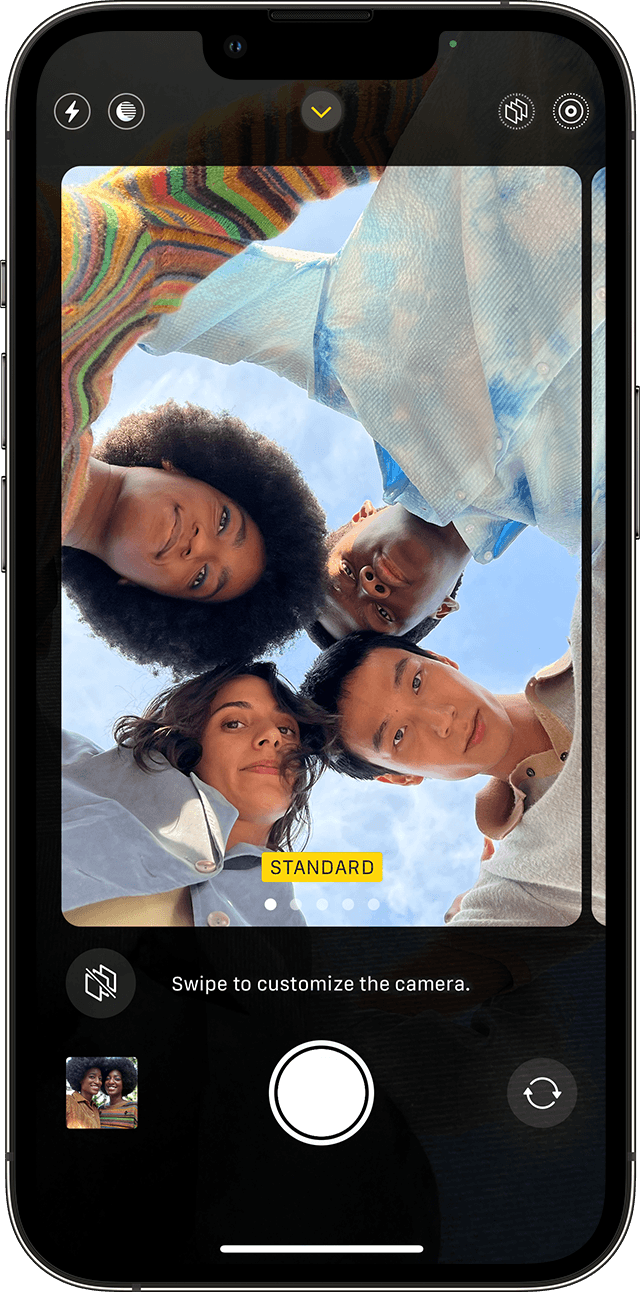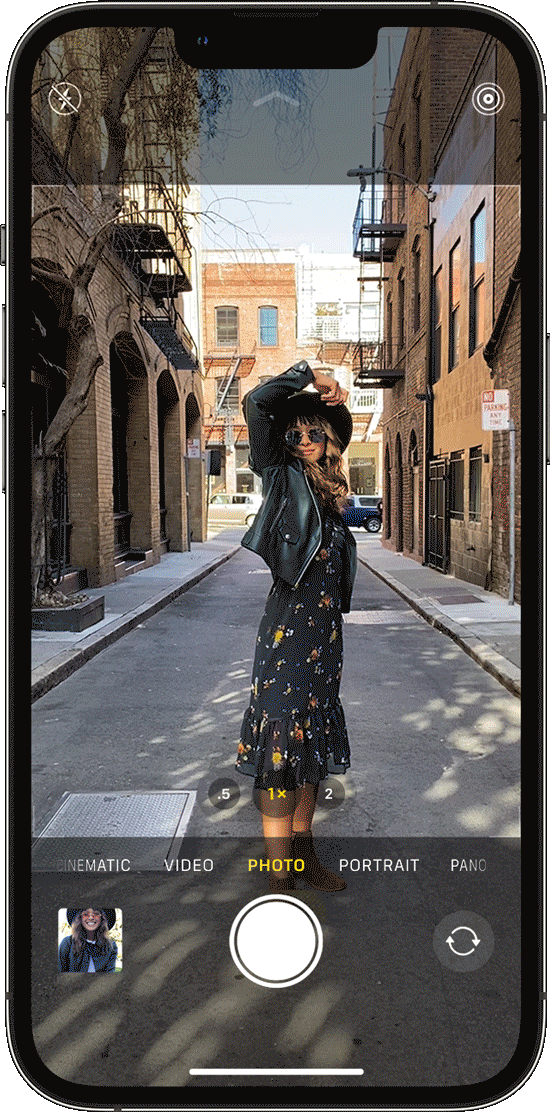How To Get The Shot On Iphone Thing
About the Camera features on your iPhone
Find out about Photographic Styles, QuickTake, the Ultra Wide camera and other camera features on your iPhone.
Lock in your look with Photographic Styles
With Photographic Styles on iPhone 13 models, you can personalise the look of your images in the Camera app. Choose a preset — Rich Contrast, Vibrant, Warm or Cool — and decide if you want to fine-tune it even further by adjusting the Tone and Warmth settings. Set your style once to use your preferred style setting every time you take a photo in Photo mode.

Set up a Photographic Style
When you open the Camera app for the first time, tap Set Up to choose your Photographic Style. Swipe through the different styles and tap Use [Style Name] on the preset that you like.
Make sure that you've set your style before you start taking photos — you can't add your Photographic Style to a photo after you've already taken it.

Capture close-ups with macro photos and video
iPhone 13 Pro and iPhone 13 Pro Max introduce macro photography, using the new Ultra Wide camera with advanced lens and auto-focus system for stunning close-ups with sharp focus as close as 2 centimetres. iPhone 13 Pro and iPhone 13 Pro Max can also shoot macro videos, including slow-motion and time-lapse.
Shooting macro in Photo and Video modes is automatic — just move your iPhone close to the subject and the camera will automatically switch to the Ultra Wide camera if it's not selected, while maintaining your framing. To shoot macro slow-motion or time-lapse videos, select the Ultra Wide camera (.5x) and move close to the subject.
You might see the Camera app transition to the Ultra Wide camera as you move your iPhone close to or away from a subject. You can turn off automatic macro switching by going to Settings > Camera, then turning off Auto Macro. To shoot macro photos and videos after turning off automatic macro switching, select the Ultra Wide camera (.5x) and move close to the subject.

Record a video with QuickTake
You can use QuickTake to record videos without switching out of photo mode. QuickTake is available on iPhone XS, iPhone XR and later.

Hold the shutter to take a video
When you open the Camera app, you will see the default photo mode. Tap the Shutter button![]() to take a photo. Then tap the arrow
to take a photo. Then tap the arrow![]() to adjust options, such as the flash, Live Photos, timer and more.
to adjust options, such as the flash, Live Photos, timer and more.
If you want to capture a QuickTake video, just press and hold the Shutter button ![]() .* Release the button to stop recording.
.* Release the button to stop recording.
With iOS 14 and later, you can hold one of the Volume buttons to capture a QuickTake video. If you have Use Volume Up for Burst enabled, you can use the Volume down button to capture a QuickTake video.
Slide to the right to lock recording
To keep recording video without having to hold the button, slide the Shutter button ![]() to the right, then release it. When video recording is locked, a Shutter button appears to the right. Tap the Shutter button
to the right, then release it. When video recording is locked, a Shutter button appears to the right. Tap the Shutter button ![]() to take a still photo during video recording. When you're ready to stop recording, tap the record button.
to take a still photo during video recording. When you're ready to stop recording, tap the record button.
Slide to the left for burst mode
Slide the Shutter button ![]() to the left and hold it to take a burst of photos, then release it to stop.
to the left and hold it to take a burst of photos, then release it to stop.
With iOS 14 and later, you can capture photos in burst mode by pressing the Volume up button. Just go to Settings > Camera and turn on Use Volume Up for Burst.
* To take videos with customisable resolution, stereo audio and audio zoom, switch to Video mode.

Automatically apply a tailored look to your photos
With Scene Detection, available on iPhone 12 models and later, the camera intelligently detects what you're taking a photo of and applies a tailored look to bring out the best qualities in the scene. To turn this feature off, go to Settings > Camera and turn off Scene Detection.

Adjust your focus and exposure
Before you take a photo, the camera automatically sets the focus and exposure, and face detection balances the exposure across many faces. You can use Exposure Compensation Control to precisely set and lock the exposure for upcoming shots.
Just tap the arrow![]() , then tap
, then tap![]() and adjust your exposure level. The exposure is locked until the next time you open the Camera app.
and adjust your exposure level. The exposure is locked until the next time you open the Camera app.
Exposure Compensation Control is available on iPhone 11, iPhone 11 Pro, and later with iOS 14 or later.

Take a mirrored selfie
With iOS 14 and later, you can take a mirrored selfie, which will capture the shot as you see it in the camera frame. To turn Mirror Front Camera on, go to Settings > Camera, then turn on the setting.
The Mirror Front Camera for photo and video is available on iPhone XS, iPhone XR and later. If you have an iPhone 6s to iPhone X, the setting will be called Mirror Front Photos and will only capture photos.

Capture photos even faster
You can use Prioritize Faster Shooting to modify how images are processed, allowing you to capture more photos when you rapidly tap the Shutter button ![]() . To turn this off, go to Settings > Camera and turn off Prioritise Faster Shooting.
. To turn this off, go to Settings > Camera and turn off Prioritise Faster Shooting.
Prioritize Faster Shooting is available on iPhone XS, iPhone XR, and later with iOS 14 or later.

Enhance your selfies and Ultra Wide photos
With Lens Correction, when you take a selfie with the front-facing camera or a photo with the Ultra Wide (0.5x) lens, it automatically enhances the photos to make them appear more natural. To turn this off, go to Settings > Camera and turn off Lens Correction.
Lens Correction is available on iPhone 12 models and later.

Do more with the camera on your iPhone
- Need to capture photos in low-lighting conditions? Learn how to use Night Mode on supported iPhone models.
- Use Live Photo to capture moments with movement and sound.
Published Date:
Thanks for your feedback.
How To Get The Shot On Iphone Thing
Source: https://support.apple.com/en-au/HT210571
Posted by: gautreauwoulace.blogspot.com

0 Response to "How To Get The Shot On Iphone Thing"
Post a Comment